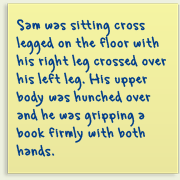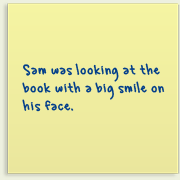Behaviour
Caring for babies
Bottle feeding
Changing a nappy
Cleaning and sterilising bottles
Daily cleaning tasks
Helping new children settle in
Preparing for a nappy change
Sleep patterns – babies
Sleep routines – babies
Toilet training
Caring for children
Allowing time for practice
Dressing/undressing
Mealtimes
Nappy change
Packing away/caring for the environment
Sleep/rest time
Toileting
Common self-help milestones
Tips for sleep and rest time
Self image
Communication
Body language
Limits and guidelines
Ways children communicate
Greeting children and families
Modelling appropriate communication
Questioning
Verbal and non–verbal communication
Acknowledging children's feelings
Listening attentively
Communicating with Aboriginal and Torres Strait Islander parents/carers
Development
Allowing time for practice
Dressing/undressing
Mealtimes
Nappy change
Packing away/caring for the environment
Sleep/rest time
Toileting
Common self-help milestones
Creative development
Language development
Modelling positive relationships
Physical development
Sharing and taking turns
Sleep patterns – babies
Sleep routines – babies
Encourage independent problem solving
Fundamental movement skills
Health, hygiene and safety
Coping with stress
Correct manual handling principles
Daily cleaning tasks
Hand washing
Hand washing poster
Manual handling overview
Toilet training
Safety checklist
Learning experiences and play
Environmentally friendly learning experiences
Learning experiences for different development areas
Creative resource materials
Arranging the environment to facilitate learning and pleasure
Indoors and outdoor areas
Creating a positive physical environment
Legal and ethical issues
Child abuse case studies
How do I recognise when a child or young person is at risk?
Tips on dealing with disclosures
Observation methods
Arranging Experiences (PDF 351Kb)
Recording observations
Rules for making observations
What you can learn from observations
Programming
Children’s interests, strengths, needs and skills
Extending the children’s interest in dinosaurs
Objective observation
Planning an OSHC environment
Behavior management plan
Planning enjoyable experiences
Planning experiences for 0 - 2 years age group
Planning experiences for 2 - 3 years age group
Planning experiences for 3 - 5 years age group
Ways children communicate
Observing movements, facial expressions and speech can give carers a good indication of how children are feeling.
Click each of the three communication types below, to find out more.
Body movements
When observing a child take close note of exactly how a child is using their body.
- What parts of the body is the child using - total body, upper/lower half, arms, legs?
- What body postures are involved - hunched, upright, awkward, graceful, stiff?
- What type of body gestures is the child making - fast, slow, jerky, definite?
Below are some examples to explain this.
 This observation does not give you much understanding about the child. He could be kneeling or sitting with his legs stretched out in front, he could be showing relaxed behaviour or looking worried as he reads.
This observation does not give you much understanding about the child. He could be kneeling or sitting with his legs stretched out in front, he could be showing relaxed behaviour or looking worried as he reads.
 This observation lets you understand more about how Sam might have been feeling as he was reading.
This observation lets you understand more about how Sam might have been feeling as he was reading.
Facial expressions
A child's face will tell you a lot about how they feel.
- eyes - are they solemn, tearful, flaring, smiling, bright, surprised, shining or dull?
- mouth - is it drooping, open, smiling, drawn, puckered, trembling?
- smile - is it full, wistful, shy, dimpled, wide, or beaming?
Have a look at these examples.
 This observation doesn't tell you how Sam was reading the book. Was he glancing at it in a bored manner, or was he looking interested as he read it?
This observation doesn't tell you how Sam was reading the book. Was he glancing at it in a bored manner, or was he looking interested as he read it?
 This observation lets you understand how Sam was reading the book, and what body language he was displaying as he read.
This observation lets you understand how Sam was reading the book, and what body language he was displaying as he read.
Language
When a child speaks, what they say and how they say it can tell you a lot about how they feel and what their needs are.
- language - what are they saying?
- voice - is it loud, soft, demanding, angry, questioning, shrill, subdued?
Can you see the difference between what these observations tell you about the child?
 Although this tells us that Christine was singing, we don't know if she was singing a sad, little tune, or a happy, bubbly tune. Describing her voice can add a lot of meaning to our understanding of Christine.
Although this tells us that Christine was singing, we don't know if she was singing a sad, little tune, or a happy, bubbly tune. Describing her voice can add a lot of meaning to our understanding of Christine.
 We get much more meaning from this observation, as we can understand how Christine is feeling.
We get much more meaning from this observation, as we can understand how Christine is feeling.